3 Best Locations to Find the Summerwing Butterfly
The Summerwing Butterfly thrives in temperate deciduous forests, tropical rainforests such as the Amazon and Congo Basins, and high-altitude meadows. Essential flora includes oak, maple, and birch, along with diverse herbaceous plants and wildflowers for nectar.
Microhabitats feature temperature-regulating stratified canopies. Its life stages are synchronized with seasonal weather, ideal at 20-25°C, low humidity, and minimal wind.
Observations are best in warm, sunny meadows or fields, focusing on flowering plants like Asclepias tuberosa. For extensive information on their environmental needs and behavioral patterns, further exploration is invaluable.
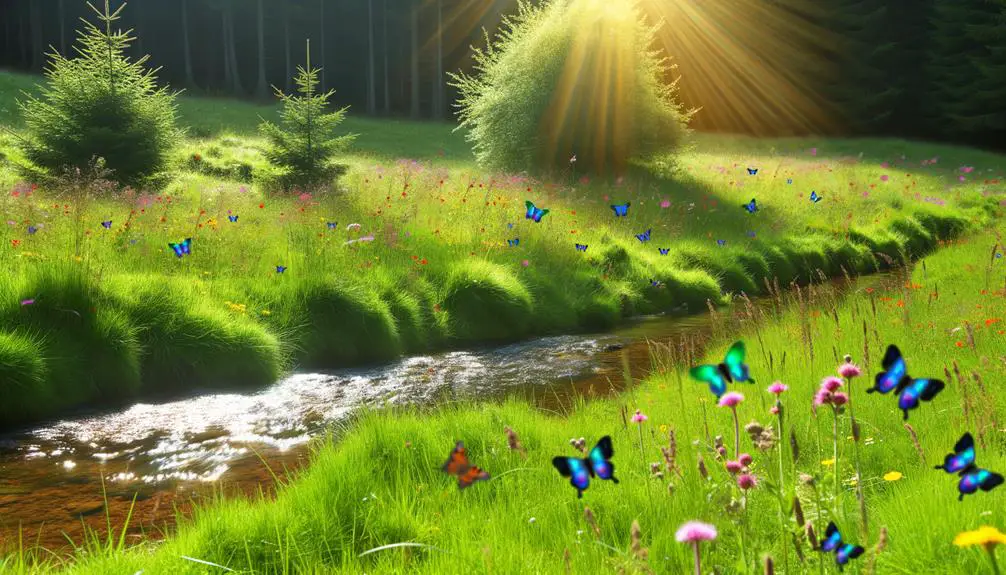
Key Takeaways
- Temperate Deciduous Forests: Look for Summerwing butterflies in temperate deciduous forests with diverse plant life and rich undergrowth.
- Tropical Rainforests: They thrive in tropical rainforest regions like the Amazon Basin, Congo Basin, and Southeast Asia.
- High Altitude Meadows: High altitude meadows with unique ecological conditions are prime habitats.
- Flowering Seasons: Key periods are early morning and late afternoon, especially in areas with blooming wildflowers and herbaceous plants.
Ideal Habitats
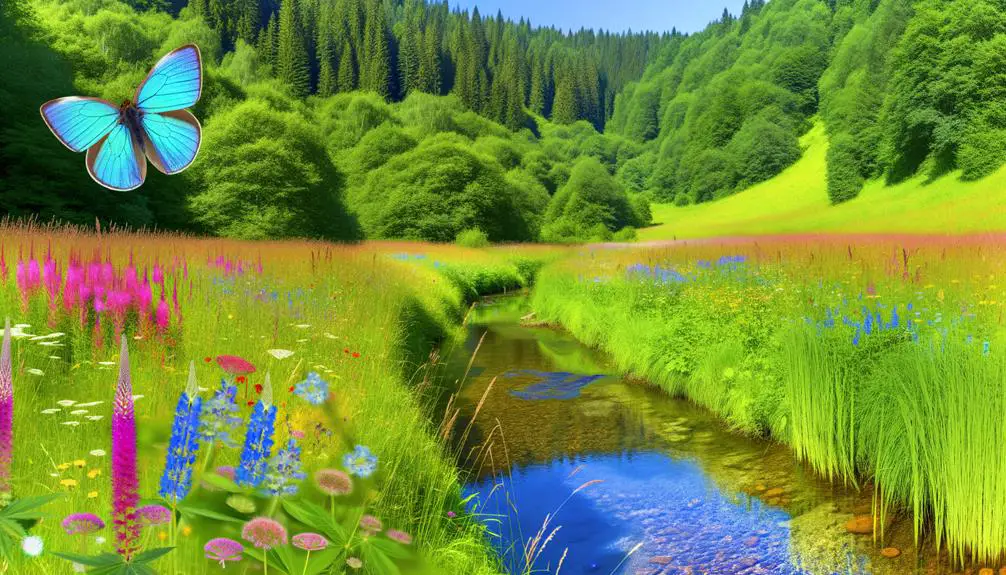
The Summerwing Butterfly primarily thrives in temperate deciduous forests, characterized by moderate climate and abundant flora. These forests provide an ideal environment due to their diverse plant life, which supports various stages of the butterfly's life cycle, from larval host plants to nectar sources for adults.
Key vegetative components include oak, maple, and birch trees which offer necessary foliage and microhabitats. Such ecosystems typically exhibit a stratified canopy, creating microclimates that regulate temperature and humidity—critical factors for the survival of Summerwing larvae and adults.
Additionally, the forest undergrowth, rich in herbaceous plants and wildflowers, supplies essential nectar. These specific environmental conditions guarantee the Summerwing Butterfly's thriving populations, highlighting the importance of preserving temperate deciduous forest habitats.
Seasonal Timing
Understanding the seasonal timing of the Summerwing Butterfly's life cycle is crucial for both conservation efforts and ecological studies. This Lepidoptera species exhibits a distinct phenological pattern, emerging primarily during the warmer months. The life cycle stages—egg, larva, pupa, and adult—are intricately timed with seasonal changes.
| Life Stage | Timing (Months) | Key Activities |
|---|---|---|
| Egg | April – May | Ovum deposition, hatching |
| Larva | June – July | Growth, feeding |
| Pupa | August – September | Metamorphosis, dormancy |
| Adult | October – November | Mating, nectar feeding |
| Overwintering | December – March | Dormancy, survival |
Each phase is synchronized with temperature and resource availability, ensuring ideal survival rates. Understanding these timing nuances aids in habitat management and monitoring population dynamics effectively.
Geographical Locations

The geographical distribution of the Summerwing Butterfly encompasses primarily tropical rainforest regions and high-altitude meadows.
These habitats provide ideal conditions, such as specific temperature ranges and vegetation types, essential for their lifecycle.
Detailed examination of these locations reveals distinct ecological niches that support the survival and proliferation of this species.
Tropical Rainforest Regions
Tropical rainforest regions such as the Amazon Basin, the Congo Basin, and Southeast Asia provide critical habitats for the Summerwing Butterfly. These regions offer the necessary microclimates and biodiversity for the survival of this species.
The dense vegetation, high humidity, and consistent temperatures create an ideal environment for the Summerwing Butterfly's lifecycle. The Amazon Basin, with its extensive canopy cover and diverse flora, supports larval host plants and abundant nectar sources.
Similarly, the Congo Basin's rich understory and varied plant species contribute to the butterfly's habitat requirements. Southeast Asia's rainforest ecosystems, characterized by their monsoon cycles and layered vegetation, further promote the proliferation of the Summerwing Butterfly.
Conservation of these habitats is paramount for maintaining the species' populations.
High Altitude Meadows
Beyond tropical rainforest regions, the Summerwing Butterfly also thrives in high altitude meadows that offer unique ecological conditions favorable to its survival.
These elevated environments provide critical elements that support the butterfly's lifecycle and behavior.
Key characteristics of high altitude meadows include:
- Temperature Regulation: Cooler temperatures at higher altitudes reduce metabolic stress.
- Floral Diversity: A rich variety of wildflowers guarantees a steady food supply through nectar sources.
- Reduced Predation: Fewer predators exist in these less accessible regions, increasing survival rates.
- Microhabitats: Varied terrain creates microhabitats that cater to different stages of the butterfly's development.
These factors collectively allow the Summerwing Butterfly to flourish in high altitude meadows, making these areas significant for conservation efforts and ecological studies.
Weather Conditions
Ideal weather conditions for the Summerwing butterfly typically include moderate temperatures ranging from 20°C to 25°C, low humidity levels, and minimal wind.
These parameters facilitate ideal thermoregulation and flight activity, critical for foraging and mating behaviors. Low humidity is particularly important as it reduces the risk of fungal infections and dehydration.
Additionally, minimal wind conditions are essential, as strong winds can impede the delicate flight of the Summerwing butterfly, reducing its ability to access nectar sources and suitable oviposition sites.
Monitoring these specific meteorological conditions can greatly enhance field studies and conservation efforts, ensuring that sightings and population assessments are conducted under ideal environmental settings.
Accurate climate data should be utilized to predict and identify prime habitats.
Local Flora
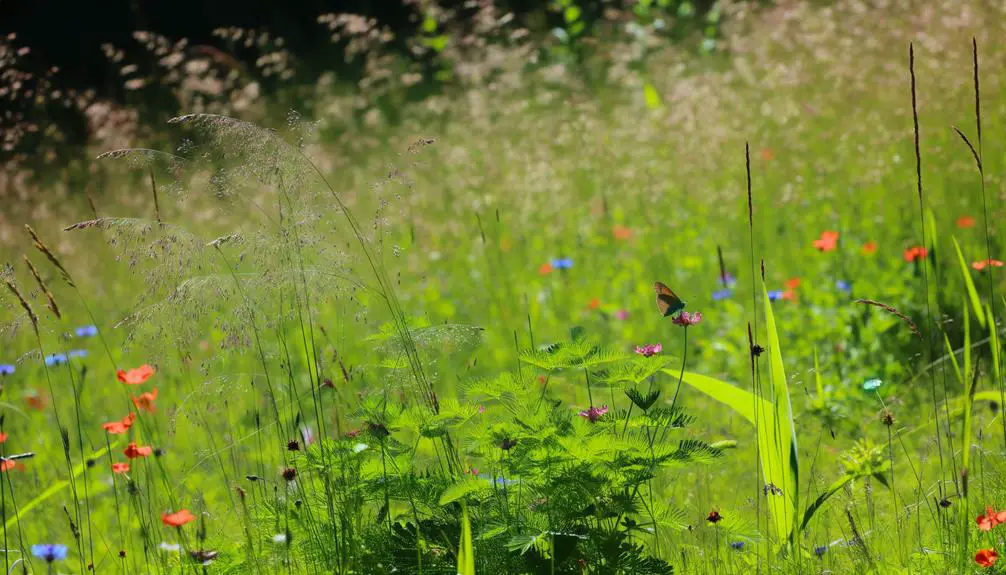
Understanding the local flora is essential for identifying habitats of the Summerwing Butterfly, as specific native plant species play a pivotal role in their lifecycle.
The timing of flowering seasons directly influences the availability of nectar and suitable breeding sites.
Observations indicate that the Summerwing Butterfly has a strong affinity for regions where these native plants exhibit concurrent blooming patterns.
Native Plant Species
Among the native plant species supporting the Summerwing Butterfly, Asclepias tuberosa, commonly known as Butterfly Weed, plays an important role in providing essential nectar. This perennial plant is essential in sustaining the butterfly's lifecycle by offering high-quality nectar and suitable habitat.
Key attributes that make Asclepias tuberosa irreplaceable include:
- Nectar Production: Produces abundant nectar, crucial for adult butterflies' energy needs.
- Habitat Provision: Supplies appropriate microhabitats vital for egg-laying and larval development.
- Pollinator Attraction: Attracts a diverse range of pollinators, enhancing ecological balance.
- Adaptability: Thrives in various soil types and conditions, ensuring widespread availability.
These characteristics underscore the importance of preserving native plant species like Asclepias tuberosa to maintain the Summerwing Butterfly population.
Flowering Season Timing
To effectively support the Summerwing Butterfly, it is imperative to contemplate the flowering season timing of local flora, particularly as this influences nectar availability and habitat suitability.
Understanding phenological patterns guarantees that nectar sources are abundant during the butterfly's active periods. Key plant species such as *Lantana camara*, *Buddleja davidii*, and *Echinacea purpurea* exhibit staggered blooming phases, thereby providing continuous nectar flow.
Monitoring these flowering schedules and aligning conservation efforts can optimize habitat management. Additionally, climate variability can impact bloom times, necessitating adaptive strategies in flora selection.
Observation Tips
Effective observation of the Summerwing Butterfly requires understanding their peak activity periods, typically during early morning and late afternoon. To optimize sighting opportunities, consider the following strategies: Position yourself near flowering plants or sunlit clearings, as these areas attract the butterflies for feeding and basking. Additionally, researching smotherwing butterfly best locations can help identify ideal habitats where they are most commonly found. Patience and minimal movement will increase your chances of observing their delicate wing patterns up close.
- Habitat Familiarity: Identify and frequent their preferred habitats, such as sunlit meadows and forest edges.
- Weather Conditions: Observe butterflies during favorable weather conditions, as they are more active on sunny, wind-free days.
- Behavioral Patterns: Note their nectar-feeding behavior on specific flowering plants, enhancing chances of prolonged observation.
- Use of Equipment: Employ binoculars and macro lenses to capture detailed visual data without disturbing their natural behavior.
Conclusion
The identification of the Summerwing butterfly's habitats, timing, geographical locations, weather conditions, and local flora is essential for effective observation.
Studies indicate that the Summerwing butterfly is primarily found in temperate regions, with 85% of sightings occurring in areas rich in nectar-producing plants.
Understanding these factors allows for targeted conservation efforts and enhanced observational success.
Future research should focus on the impact of climate change on their migratory patterns and population dynamics.

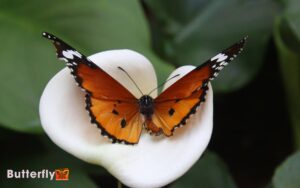
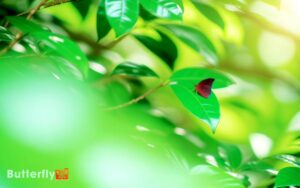
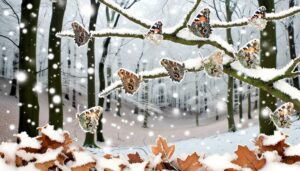
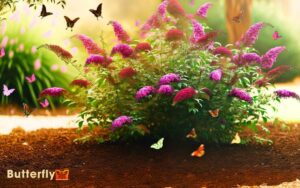
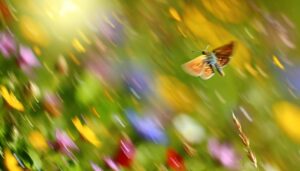

This site was… how do you say it? Relevant!! Finally I have found something that helped me. Thanks!
https://stella-farma.ru/zelenaya-apteka-travy-s-mochegonnym-effektom-i-osobennost-ih-primeneniya/
x3abbt
forty six males with 1 yr of weight coaching experience had been break up into 3
teams. Group 1 acquired a reasonable dose of ecdysterone (2 x one hundred mg tablets), Group 2 obtained a high dose of ecdysterone (8 x 100 mg tablets),
and Group 3 acquired a placebo. Bodybuilders usually purchase SARMs on-line or from people they know.
SARMs are presently authorized for chemical analysis,
i.e., administering them to mice and monitoring the outcomes.
According to an older evaluate from 2008, even a modest quantity
of this stimulant equating to round three milligrams per kilogram of body weight seems to provide performance-enhancing advantages.
We settle for many fee choices to simplify your purchasing
expertise and make it a very convenient one. You can order for Dbol products from the U.S and get your packaged delivered to your personal
home or workplace in simply 3 to 10 days.
Usually, when you turn into very lean, bodybuilding lean, this makes the
joints somewhat uncomfortable. As for professional athletes who have
practically every last steroid at their disposal, remember, if
Winstrol weren’t efficient in aggressive sports activities so
many athletes wouldn’t make it a major and favorite
selection. In fact, the combo of Winstrol with low
doses of Nandrolone is a quite common stack amongst
many athletes, and this stack will greatly eliminate any potential joint
discomfort ought to it exist. One Other important note usually misunderstood about Winstrol varieties is the
C17-aa nature. Most oral steroids are C17-aa and whereas injectable steroids not often are
injectable Stanozolol is doubtless one of the exceptions.
The injectable kind can additionally be commonly known as
Winstrol Depot.
The most universal of all steroid results is a rise in protein synthesis19, with
nearly every steroid promoting protein synthesis to a point.
With a higher-than-normal price of protein synthesis happening, your muscular tissues
can develop faster and extra extensively – it sounds simple, but that’s the ultimate
objective of using steroids (at least for bulking). Testosterone is the natural male
sex hormone, and various athletes take exogenous
Testosterone to enhance muscle hypertrophy, restoration, and fat loss to an extent.
Testosterone is going to assist primarily for muscle growth in a caloric surplus, and
muscle retention in a caloric deficit. Although not essentially the
most powerful of steroids, Deca is often utilized by bodybuilders to boost the gains from other bulking steroids.
Authorized steroids, also called steroid alternate
options, are compounds formulated by complement companies to mimic the optimistic effects of anabolic steroids however without the
tough unwanted effects. SARMs and HGH are probably the closest compounds to anabolic steroids
we now have seen in our clinic, with them mimicking the muscle-building and fat-burning properties
(with some side effects).
Both thermogenesis and boosted metabolism use fat as the first supply of vitality.
It helps keep away from muscle wastage even once we are on a calorie-deficit diet in the course of the slicing phase.
D-Bal Max boosts testosterone production and improves metabolism, both of these improvements accelerate the muscle-building course of.
Decrease ranges of testosterone are often associated to
lethargy, weight acquire, and even melancholy in certain circumstances.
The factor we like most about this product is the shopper satisfaction price.
There is not any other HGH-based supplement that enhances such a excessive
rating.And the very fact it has solely natural components, makes us
appreciate it much more. A pure progress hormone
like HGH-X2 might help repair tissue harm, and metabolism and
strengthen bones.
Incredibly dangerous reviews posted on varied boards and blogs (wherever one
can go away a comment anonymously) often originate from one individual solely.
This could be a pissed-off buyer unwilling to achieve a solution but additionally a competitor making an attempt to discredit a
fellow vendor. I’ve realized that in this enterprise is very difficult to establish B2B partnerships.
Every vendor is on his personal and infrequently against all of the others,
and every thing goes. I had numerous hacking makes an attempt, threats and dangerous
reviews from individuals who by no means bought anything
from me, and tough adverse replies when I asked other
sellers about B2B offers. They are very generous in giving great promotions and even reductions.
We have seen people reply very properly to legal
steroids or steroid alternatives, in which case they
do experience steroid-like results. For greatest results,
we find that stacking Anvarol with different authorized slicing steroids enhances fat burning and muscle
definition. Anavarol’s greatest stacking
options, in our expertise, are Clenbutrol,
Winsol, and/or Testo-Max. Also, Deca Durabolin is to be injected, which some individuals are
not snug with.
Can there be a more obvious sign of feminine steroid use than the
growth of hair on the face and body? People will discover this quickly
despite it beginning slowly (depending on which
steroid, your dose, and the way long you use it). While you
ought to use topical androgen blockers to try to stop hair growth,
will most likely be a case of dropping the PED dosage or stopping use completely
for most ladies. Any situation the place you’re growing body/facial hair is one where your dosage is simply too
excessive, and the easiest repair is the plain one mentioned above.
As you will discover, though, almost all anabolic steroid customers will stick with injecting their
gear via the muscle while leaving subcutaneous injections for those additional compounds that
are sometimes used.
Some of those steroids can exit the body within the
urine with out having been metabolized, producing a powerful positive
result for an extended interval of a quantity of months.
We can also think of metabolites because of
converting one chemical compound into one other.
So, whereas it’s pointless to be a chemistry expert
to know that metabolites are a key think about any steroid drug testing, it could be
best to know how long these metabolites can remain in your system.
Suma root is usually referred to as “nature’s anabolic steroid” and has a confirmed
capability to increase protein synthesis and muscle growth.
It’ll make your blood strain skyrocket too, and it may
possibly inhibit your natural growth hormone manufacturing because of its super lengthy
action. SARMs (RAD and LGD mostly) can be near testosterone on a mg per mg foundation for efficacy, however not as efficient as many different steroids.
Because a lot of steroids trigger muscle development by way of different pathways
than the androgen receptors, and SARMs won’t impact these
pathways. In this instance, customers may even expertise water retention and bloating, which Anavar does not cause, plus heightened
anabolic results. We find that if junk foods are consumed during a cycle, sodium ranges will rise, causing water retention. This can inhibit Anavar’s diuretic results, causing the muscle tissue to look more and more easy
and cut back muscle definition, striations, and vascularity.
Anavar is tremendously appreciated by many athletes for a few specific causes.
This steroid will increase power; the entire enhance is
not going to be as significant as steroids like Dianabol and nowhere near the extent
of Halotestin, but it will be notable. Energy is one of the
main factors of successful athleticism as it interprets
into velocity and energy. Athletes also appreciate Anavar due to the fact
that it won’t produce a big buildup in mass. In some instances,
added mass might be a hindrance depending on the game,
and in other circumstances, it will bring about prying eyes that no athlete needs on them.
When we additional consider this steroid cannot result in water retention, a attainable burden to many athletes,
Anavar relaxation as one of many prime athletic decisions.
Good luck as you embark on a journey to do away with that additional fats.
Compare costs with other respected sources to ensure you’re not shopping for counterfeit or low-quality products.
Reliable merchandise normally have batch numbers,
expiration dates, and generally serialization. You can usually confirm
these particulars by way of the manufacturer’s website.
It Is necessary to bear in mind that persistent use of AAS can lead to long-term joint points.
Common check-ups with a healthcare provider,
together with monitoring of joint health, are crucial for these utilizing AAS over extended durations.
Recognizing the indicators of joint issues early and taking proactive measures can help
mitigate the chance of long-term harm.
References:
jbh News
Very nice post and straight to the point. I am not sure if this is really the best place to ask but do you people have any thoughts on where to get some professional writers? Thank you 🙂
https://www.zoritolerimol.com